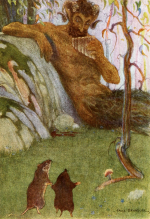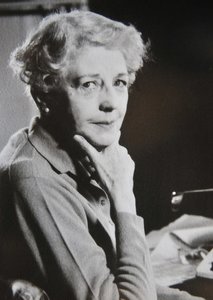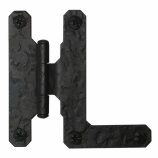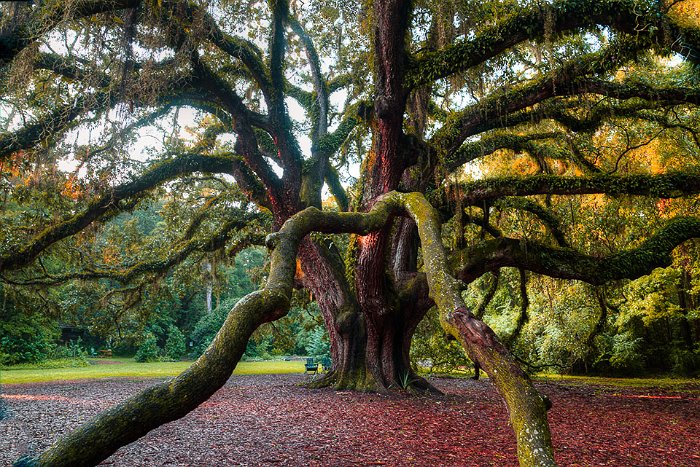Leitmotifs in Laura's Life
Leitmotif - a recurrent theme throughout a musical or literary composition, associated with a particular person, idea, or situation.
One can't spend so much time around Laura's legacies without discovering certain mysteries that are still unraveling. I call these particular mysteries leitmotifs since they seem to be shadows of something Laura was trying to tell or show us. Unfortunately the harsh light of time, loss and death have dimmed the shadows, but they are still there for those who wish to look. Three of the more fascinating of Laura's leitmotifs are druids, witches and the reoccurring image of Pan, the horned god of the Greeks.
In writing all of this I will seek to discover why Laura chose certain words and images and what authors or events may have influenced her. We no longer have the ability to ask Laura these things and so are left searching for clues in the few pieces of correspondence and books she wrote. Laura herself used words like "witch" in her last book and often connected the word to how the surrounding community viewed her. When using the word here I do so with the understanding that my definition, and perhaps hers, is that this word is a label created out of prejudice to unjustly group people whose behavior or lifestyle fell outside of the norms of the community in which they dwelled.
To
begin I will make a supposition, one I can't support with
hard evidence, but one that I think is probable and would
explain some of Laura's later writings and imagery.
This supposition begins with a book written by
Margaret
Murray that was published in 1921. The book was
entitled "The
Witch-Cult in Western Europe", a book heavily influenced
by a classic, then in its 3rd edition, called "The Golden
Bough".
book written by
Margaret
Murray that was published in 1921. The book was
entitled "The
Witch-Cult in Western Europe", a book heavily influenced
by a classic, then in its 3rd edition, called "The Golden
Bough".
Margaret's book detailed what she believed was evidence of a pre-Christian religion in Europe that had worshipped a horned God that represented the cycle of seasons, the birth, death and rebirth of the world. The worshippers of this pre-Christian religion were later disparagingly labeled as "witches" and both the religion and its followers were suppressed by the Church, finally being driven underground by the 17th century. Margaret believed that pieces of this suppressed religion could be found in the testimony from witch trials, lingering beliefs in various "little people" such as gnomes or fairies and in many "old wives tales" scattered throughout old Europe. Margaret followed up her book with another in 1931 and wrote articles for the Encyclopedia Britannica about this prehistoric religion until her death in 1963.
Margaret's books were extremely popular through the 1940's here in the United States. Her claims of a prehistoric religion with female priests echoed with those espousing freedom for women, open sexuality and opposition to the oppression of the Church. All of this makes it very likely during Laura's education at the University of Iowa, (1925 - 1946), that she was exposed to Margaret's work.
So where can we see the influences of Margaret's books in Laura's writings? Let's start with the Horned God that figured so significantly in Margaret's pagan religion. Laura's Master's Thesis completed in 1936 was in fact a faux Greek play she titled "Cupid". For those interested in reading her Master's Thesis please download a copy here, (it is my belief that the character of Psyche in the play is Laura herself, another story to follow this one :). Here is the dialogue from page 19 of the play in which we overhear the conversation between Pygmalion and his daughter Psyche:
PYGMALION
(expanding) There is not a story in
the whole wide world that I can not believe.
PSYCHE
But you do not mean it.
Then you would have to believe in Arcadia.
PYGMALION
(with a mimicry of youth in his
eyes)
I believe in Arcadia.
Arcadia is on this mountain, Arcadia to us.
PSYCHE
No. Not In that Arcadia.
PYGMALION
Where then?
PSYCHE
I hardly know.
But there come some times in my life when my
heart like a dryad flies to its lair and my wild soul takes
flight toward something which is far from this earth but
which has always hovered there and which in truth is what I
am.
PYGMALION
Is it true?
Then you believe in Pan, the fauns, and the
dryads?
(She nods assent.)
And tonight we are in our lair?
PSYCHE
I have not told you everything.
I have memory of a place and of a magical
time in which the moon was very much brighter than here and
the sky was bluer and nearer the ground.
The trees were alive and used to talk and
the wind made me cry out for joy when it touched me.
I remember, too, that the nights were ever
so much softer than these, and every night there was a new
wonder for me.
All the land was ruled by one who thought
only to make me happy.
When the day was done and the hush of
moonrise fell on the forest he would tell me stories that
made me tingle from head to foot with rapture.
I have never heard any other stories half so
beautiful.
And when the joy became too great he would
play a weird little tune on his reed pipes that always
brought sleep.
At length, there came a parting and he took
me to the Crossroad and told me of a charm that he had given
me which I must never lose because it would keep me young
and give me power to return.

 England during the early part of the century and was likely
one read by Laura during her childhood. The 1913
edition contained a frontispiece as shown here on the left,
an illustration drawn from the short story in the book
called, "The Piper at the Gates of Dawn", (later the title
of the debut album by Pink Floyd). In the story, Mole
and Rat find Otter's missing son in the care of Pan who, at
in the end, removes the memory of the meeting from their
minds, "lest the awful remembrance should remain and
grow, and overshadow mirth and pleasure."
England during the early part of the century and was likely
one read by Laura during her childhood. The 1913
edition contained a frontispiece as shown here on the left,
an illustration drawn from the short story in the book
called, "The Piper at the Gates of Dawn", (later the title
of the debut album by Pink Floyd). In the story, Mole
and Rat find Otter's missing son in the care of Pan who, at
in the end, removes the memory of the meeting from their
minds, "lest the awful remembrance should remain and
grow, and overshadow mirth and pleasure."
The imagery of witches weaves throughout Laura
writings, sometimes very distinct, sometimes just a
 hint
or shadow at the door’s edge, but regardless always very
present. I am
not sure why Laura included them as much as she did but I am
often reminded of a quote by a British authoress whom Laura
may have even met named
Nora
Lofts, (picture to the left).
Nora wrote in her 1954 book, Bless this House,
the following dialogue for her character of Lady Alice
Rowhedge, “Perhaps I
am the only person who, asked whether she were a witch or
not, could truthfully say, "I do not know. I do know some
very strange things have happened to me, or through me."
hint
or shadow at the door’s edge, but regardless always very
present. I am
not sure why Laura included them as much as she did but I am
often reminded of a quote by a British authoress whom Laura
may have even met named
Nora
Lofts, (picture to the left).
Nora wrote in her 1954 book, Bless this House,
the following dialogue for her character of Lady Alice
Rowhedge, “Perhaps I
am the only person who, asked whether she were a witch or
not, could truthfully say, "I do not know. I do know some
very strange things have happened to me, or through me."
As early as Chapter II of Laura’s last book,
Lichgate on High Road,
we hear the soft rustle of a witch when describing how
visitors often imagined her home,
““It reminds me of ….” Some of
the Black Forest, some of the Alps, some of Saxon
England—all, of the far away, and some, of the long ago.
Of the Hansel and Gretel
cottage, the Anne Hathaway house, or the rooftops of Mother
Goose."
It would be easy to miss the witch’s shadow in this part
of Laura’s book, I did for quite some time but if you know
anything of Hansel and Gretel, the cottage in the story was
the home of a witch determined to eat the
two children.
The next sentence following this description of her
home’s appearances in other’s eyes is probably one my
favorite from her book.
“Here was a curiosity, out of
time and place, a fairy tale creation, come to settle, as if
by a spell, in the Florida sunshine.”
As if by spell as if conjured and if so by whom?
At the end of Chapter VI as Laura describes the period of construction where the cottage was wrapped in tar paper as workmen labored on the roof. Of the cottage she says, “Ominous it must have appeared, black, in the somber shade of the pine grove, for I learned years later that passersby called it the Witch’s hut.” As with the mention of the Hansel & Gretel cottage above it would be easy to just read this and not notice the subtleness present in a single letter. In the original book the word witch is capitalized. This indicates formality, possessiveness, ownership, the cottage isn’t a generic witch’s home, no, it the Witch’s home, was Laura leaving us clues as to who she was?
It was during this time of the cottage’s
construction that we next encounter a reference to a witch.
In Chapter VIII, Laura relates visits she received
during her first few months as the cottage stood, still
unfinished, but livable.
“In quiet moments I could recall
curious visitors to the pine woods, where I lived in
isolation, at least a thousand feet from my nearest
neighbor.
There was the man who came
looking for hound dogs, one who wanted a plumber, and a
third who inquired whether I did “reading.”
The last sought help
through divination in finding important papers conveying
ownership to land.”
Here again we could easily pass over the words
without giving them deep thought, “reading” referring to
some sort of Southern folk divination but obviously
regardless of whether Laura helped or not, she took the time
to find out what the person asking needed and remembered it
showing it might have been more than just a passing
conversation.
Oddly in light of these last revelations the next
two quotes tell of things done to protect the cottage from
witches. In
Chapter X she mentions hinges for the front and back doors
by saying,
“The front door swung open on H
and L hinges from a forge in North Carolina and lamps from
the same iron-forge lighted the way to the dwelling…”
Once again a shadow passes for the H and L hinges
mentioned have a peculiar history.
The H and L refers to a type of hinge used for
hanging heavy doors, (see picture), H and L comes from their shape and is an old term for this type of hinge, old
enough in fact to have folklore connected to it.
This folklore claims that early settlers to the
United States installed these hinges on their home and barn
doors to protect themselves from witches, H and L standing
for “Holy Lord” and their “cold iron” constitution
considered an anathema to fairy and witch alike.
No one has ever found the origin for this legend and
as many dispute the folklore as support it, but like much
folklore it refuses to go away.
from their shape and is an old term for this type of hinge, old
enough in fact to have folklore connected to it.
This folklore claims that early settlers to the
United States installed these hinges on their home and barn
doors to protect themselves from witches, H and L standing
for “Holy Lord” and their “cold iron” constitution
considered an anathema to fairy and witch alike.
No one has ever found the origin for this legend and
as many dispute the folklore as support it, but like much
folklore it refuses to go away.
The last quote opens Chapter XIV, the closing
chapter of Laura’s book,
“The Druids believed a holly tree
near the house could, with its magical power, ward off
witches.”
This association of the holly tree with protection is
very old.
Legends ascribe the ability for the tree to ward off poisons
and lightening along with the supernatural and for all these
reasons Laura surrounded the cottage with holly.
Lastly, as with the story of the Pan related before
this, witches appear in the book,
Wind in the Willows.
As stated before, the last page of Laura’s book is
taken from Kenneth Grahame’s book and speaks to the
characters affection for home.
The witch reference here is a bit more esoteric but
bear with me while I show you the path.
In Wind in the Willows, the only reference to a witch is rather oblique
and comes when Mole is describing a small pond in the
forecourt of a building.
In the pond is a
“large silvered glass
ball that reflected everything all wrong and had a very
pleasing effect.”
The silvered ball in question was called a “witches
ball” and they were manufactured near Bristol, England from
about 1790 until the 1870’s.
Originally they were clear rounded flasks to hold
holy water and were later silvered to reflect though the
image reflected would be upside down.
This ability to reflect “everything all wrong” was
thought to give the flask extra power to protect against
witches and evil.
These flasks later evolved into the shiny balls we
place in gardens and continue to be associated with good
luck and protection.
Interestingly enough, the same page of the book
that mentions Mole and his observations contains some telling
words just a couple of paragraphs later.
While Rat is running around Mole’s home making
comments about it he says the following, “”What a
capital little house this!” he called out cheerily.
So
compact!
So well-planned!
Everything here and everything in its
place!” I
can picture Laura as a child reading all these words and
storing them away for the home she would one day want for
herself.
So
here we are all these years after her death and still
puzzling over who Laura was.
For everyone who knew her and that I have
interviewed, she was or believed in this thing or that.
For me it is still all a grand puzzle and one I enjoy
spending time trying to figure out.
Did Laura think of herself as a witch?
In our current terminology and understanding
undoubtly not.
But in the understanding of Margaret Murray’s book mentioned
above, then yes, she was in line with the women in the past
who were midwives, herbalists, caregivers, caretakers of
nature, those who saw the birth, death and rebirth of the
world as something incredibly beautiful, incredibly special.
Had Laura lived before the 17th century
she would have been a part of that maligned group whose
lifestyle and beliefs would have condemned her.
Even in the 20th century she suffered
enough, loneliness, misunderstanding, and discrimination.
